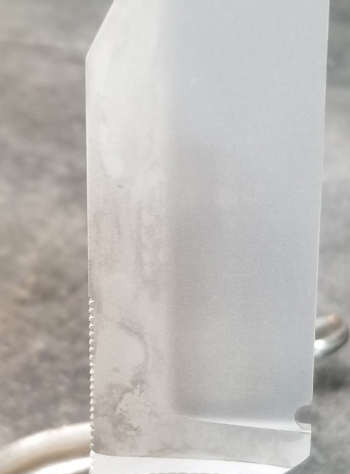MTBob
Well-Known Member
Can anyone tell me what causes the discoloration of the steel in this photo? It is heat treated 80CrV2 from AKS, coated with ATP641, 5 min soak at 1575F, quenched in Canola Oil, tempered at 375. Post heat treat, the blade was ground flat (by hand) prior to adding the primary grind. It has been repeatedly media blasted with 70 grit AO (@100 PSI) in advance of doing an acid etch. The blasting failed to remove the discoloration / blotched appearance. It's noticeable that the discoloration shows up only on the spine area, not in the primary grind area. Even after an acid etch (FeCL/vinegar - 1 1/2 min), the dicoloration was still there.
I suspect this discoloration is caused by decarburization, but I've never seen it show up like this before. Is there something in the heat treating process that I could have done different to avoid this? What is surprising is that it showed up after grinding the blade flat, and continued to show up after aggressive media blasting.

I suspect this discoloration is caused by decarburization, but I've never seen it show up like this before. Is there something in the heat treating process that I could have done different to avoid this? What is surprising is that it showed up after grinding the blade flat, and continued to show up after aggressive media blasting.


